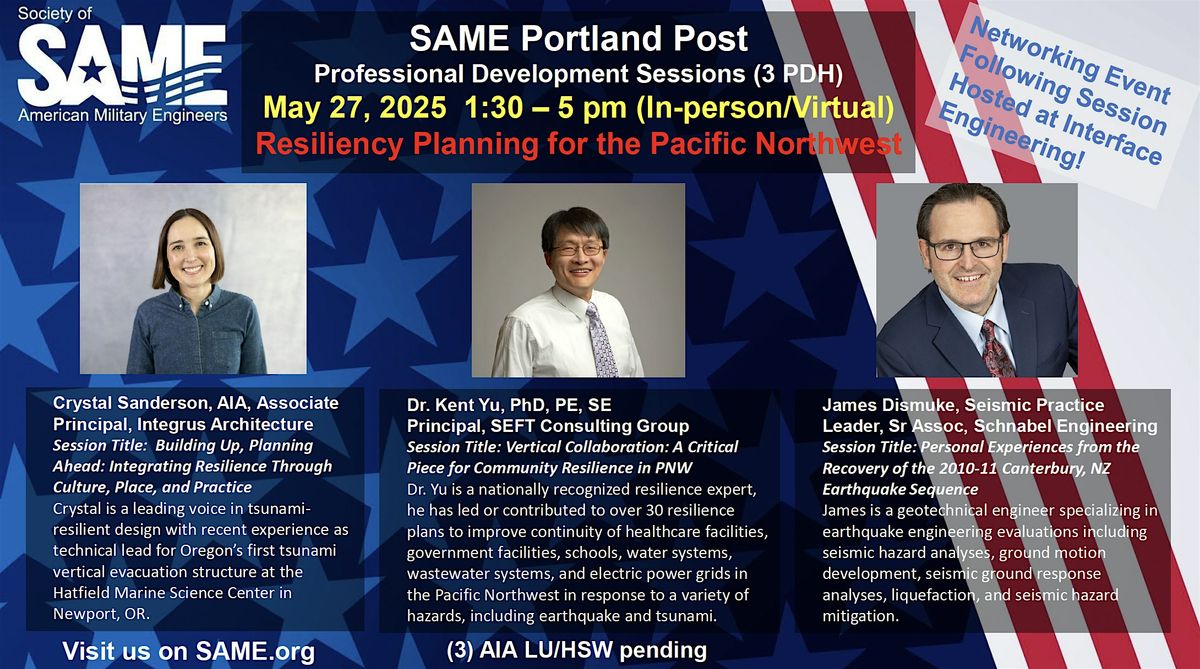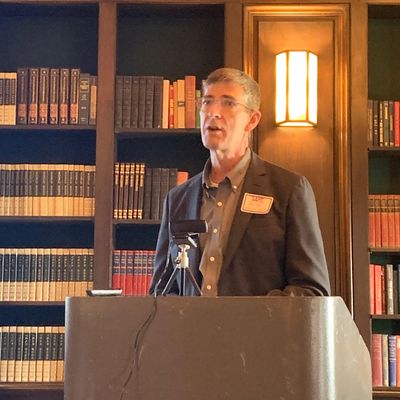SAME Portland Post Resiliency Planning for the Pacific Northwest
Schedule
Tue May 27 2025 at 01:30 pm to 05:00 pm
UTC-07:00Location
100 SW Main St ste 1600 | Portland, OR

About this Event
Please join us for a half-day professional development opportunity to learn about various resiliency planning initiatives within the Pacific Northwest. The Portland Post has coordinated three presentations by leading experts in this critical field. These sessions will provide three professional development hours and AIA LU/HSW credits are pending. There will be a Q&A session following the presentations that leads into a networking event for in-person attendees only. The in-person event is limited to 40 people so order your tickets now so you do not miss the networking opportunity with local government and private industry professionals. A virtual option is also available and the virtual meeting information will be emailed to ticket holders.
Session 1: Building Up, Planning Ahead: Integrating Resilience Through Culture, Place, and Practice by Crystal Sanderson, AIA, Associate Principal, Integrus Architecture
Learning Objectives:
- Recognize the role of place-based identity in shaping community resilience efforts, and discuss how cultural, historical, and geographic characteristics influence both risk perception and preparedness behaviors.
- Differentiate between scales of resilience, from individual and household preparedness to community-wide strategies, and explain how these layers interact during a tsunami event.
- Describe key components of emergency preparedness specific to tsunami risk, including available local and regional resources for evacuation, communication, and recovery.
- Discuss how TVERT structures can serve as teaching tools for natural disaster emergency preparedness.
Crystal is a leading voice in tsunami-resilient design with recent experience as technical lead for Oregon’s first tsunami vertical evacuation structure at the Hatfield Marine Science Center in Newport, OR.
Session 2: Vertical Collaboration: A Critical Piece for Community Resilience in PNW by Dr. Kent Yu, PhD, PE, SE, Principal, SEFT Consulting Group
Learning Objectives:
- Review seismic vulnerability of the built environment and resilience progress in Oregon and Washington
- Understand criticality of vertical collaboration with federal agencies to further advance regional seismic resilience
- Discuss roles and responsibilities for federal agencies and A/E/C stakeholders to improve functional recovery of the built environment
Dr. Yu is a nationally recognized resilience expert, he has led or contributed to over 30 resilience plans to improve continuity of healthcare facilities, government facilities, schools, water systems, wastewater systems, and electric power grids in the Pacific Northwest in response to a variety of hazards, including earthquake and tsunami.
Session 3: Personal Experiences from the Recovery of the 2010-11 Canterbury, NZ Earthquake Sequence by James Dismuke, Seismic Practice Leader, Sr Associate, Schnabel Engineering
Learning Objectives:
- Expect your life to be disrupted for several years after the earthquake, even if you do not experience direct damage or injury.
- Understand that achieving a no-collapse or life safety design performance does not ensure that a building or facility remains serviceable after the earthquake.
- Be prepared with:
- Disaster response plan and trained land and building safety assessors
- Know where to find your data (e.g., geotechnical data, structural plans, utility plans)
- Have design guidance ready to ensure that everyone is rebuilding in a reasonable way
James is a geotechnical engineer specializing in earthquake engineering evaluations including seismic hazard analyses, ground motion development, seismic ground response analyses, liquefaction, and seismic hazard mitigation.
Where is it happening?
100 SW Main St ste 1600, 100 Southwest Main Street, Portland, United StatesEvent Location & Nearby Stays:
USD 87.21

![Shelley [TEST]](https://cdn.happeningnext.com/events4/banners/dfcd04fc04ed86c50b8533bc770e565baa9d5f5be911a87f632ee52b2e834c17-rimg-w1200-h1200-gmir.jpg?v=1701814214)


















